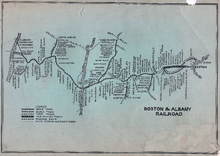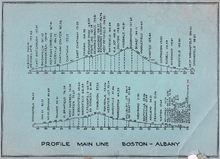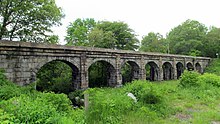|
Boston and Albany Railroad
The Boston and Albany Railroad (reporting mark B&A)[1] was a railroad connecting Boston, Massachusetts to Albany, New York, later becoming part of the New York Central Railroad system, Conrail, and CSX Transportation. The mainline is currently used by CSX for freight as the Berkshire Subdivision and Boston Subdivision. Passenger service is provided on the line by Amtrak, as part of their Lake Shore Limited service, and by the MBTA Commuter Rail system, which owns the section east of Worcester and operates it as its Framingham/Worcester Line. History   When the Erie Canal opened in 1825, New York City's advantageous water connection through the Hudson River threatened Boston's historical dominance as a trade center. Since the Berkshires made construction of a canal infeasible, Boston turned to the emerging railroad technology for a share of the freight to and from the Midwestern United States.[2] The Boston and Worcester Railroad was chartered June 23, 1831 and construction began in August 1832. The line opened in sections: to West Newton on April 16, 1834; to Wellesley on July 3; to Ashland on September 20; to Westborough in November 1834; and the full length to Worcester on July 4, 1835.[3] The original single-track line was double-tracked from Boston to Framingham in 1839, and on to Worcester by 1843. In 1843 the B&W introduced season passes to West Newton for $60, effectively introducing the concept of commuter rail.[3] The Western Railroad was chartered February 15, 1833 and incorporated March 15, 1833 to connect the B&W to the Hudson and Berkshire Railroad at the New York state line.[4] Construction began in 1837, and the Eastern Division to the Connecticut River in Springfield opened on October 1, 1839. The summit of Charlton Hill drainage divide between the Atlantic coast and the Connecticut River is a rock cut 57 mi (92 km) west of Boston. The Western Division, through the Berkshire Hills, opened in sections from both ends from the state line to Pittsfield May 4, 1841, West Springfield to Chester May 24, 1841, Springfield to West Springfield (across the Connecticut River) July 4, 1841, Pittsfield to "Summit" August 9, 1841, and Chester to Summit September 13, 1841. The summit through the Berkshires is known as Washington Hill. Eastbound trains climb 6 mi (9.7 km) of 1.4% grade while westbound trains climb 10 mi (16 km) of slightly steeper grade to reach the 4 mi (6.4 km) of fairly level track across the drainage divide between the Connecticut and Hudson Rivers. On October 4, 1841, the first train ran along the full route. The only true tunnel on the B&A is State Line Tunnel in Canaan, New York, about 2 mi (3.2 km) west of the Massachusetts state line. The original bore was augmented by an improved-alignment second tunnel in 1912, and the original bore was abandoned in the late 20th century.[2] The Castleton and West Stockbridge Railroad was incorporated in New York in 1834 as the New York part of the Western Railroad, and changed its name to the Albany and West Stockbridge Railroad (chartered May 5, 1836, organized May 20). Construction began in December 1840 and the line opened from Greenbush (east of Albany) to Chatham on December 21, 1841, and to the Massachusetts state line on September 12, 1842. It was leased to the Western Railroad for 50 years from November 11, 1841. This railroad replaced the Hudson and Berkshire Railroad east of Chatham, which was abandoned around 1860. The connection from Boston to Albany formed the longest and most expensive point-to-point railroad yet constructed in the United States.[2] Two mergers, on September 4, 1867, and December 28, 1870, brought the three companies, along with the Hudson and Boston Railroad, together into one company, known as the Boston and Albany Railroad. The New York Central and Hudson River Railroad leased the B&A for 99 years from July 1, 1900. This lease passed to the New York Central Railroad in 1914; throughout this, the B&A kept its own branding in the public eye. The NYC merged into Penn Central on February 1, 1968. New York Central began a major modernization program in 1924. The Castleton Cut-Off with a very large hi-level bridge over the Hudson River was built from the B&A at Post Road to a new rail yard at Selkirk, New York, to avoid the steep NYC grade from the Hudson River up West Albany Hill. Berkshire locomotives were designed to provide faster freight service over the B&A.[2] In 1883, the B&A acquired track then owned by the New York and New England Railroad as far as Newton Highlands, and, in 1884, began the construction of a line northwest to the B&A mainline, creating a commuter loop. "The Circuit," as this route was called, officially opened in May 1886, providing double-track operation from downtown Boston through Brookline to Newton Highlands, then north into Riverside, and four tracks on the mainline from Riverside back to downtown so that commuter and mainline operations did not conflict. By 1889, as many as 35 trains traveled the Circuit daily, providing commuter service. In 1899, the new South Station union station opened in Boston, a few blocks northeast of the old terminal. That terminal had been located on the west side of Utica Street (Boston, from Kneeland Street south to Harvard Street, now part of the South Bay Interchange. Even earlier, the terminal was in the block bounded by Kneeland Street, Beach Street, Albany Street (now Surface Artery), and Lincoln Street. By the early part of the 20th century, commuter rail service was provided east of Worcester, with intercity rail continuing on west. During the 1940s period of peak passenger volume, the New Haven Railroad (with the cooperation of the New York Central) ran several Boston-New York City trains along the route to Worcester and Springfield and then south. The service included an overnight train with sleeping car service.[5][6][7] The last passenger service on the line on April 30, 1971, before the creation of Amtrak was an unnamed Chicago-bound successor to the New York Central's New England States.[8] The intercity trips were taken over by Amtrak on May 1, 1971, and, on January 27, 1973, the MBTA acquired the line east of Framingham. Service beyond Framingham was discontinued October 27, 1975, as the state did not subsidize it. Conrail took over Penn Central on April 1, 1976. On September 26, 1994, some rush hour trains started to serve Worcester on Conrail trackage (which became CSX trackage on June 1, 1999), extending to other times beginning on December 14, 1996. The MBTA acquired the rest of the line from Framingham to Worcester as part of an agreement announced in 2009.[9][10] As part of the deal, clearances on the line west of Interstate 495 were improved, permitting full double stack service from Selkirk Yard in New York to an expanded CSX intermodal freight facility in Worcester and a transload facility near I-495. The deal was closed on June 17, 2010.[11] CSX's Boston Subdivision retains the right to use certain MBTA-owned track. Since 1959, the former "Circuit" line, later called the Highland branch, has been used as the grade-separated right-of-way of the MBTA's Green Line D branch light rail line. Named trainsThe Boston & Albany hosted many named long-distance trains of the New York Central system. Below is a list of named trains effective as of November 12, 1939. Westbound
Eastbound
Southbound
BranchesGrand Junction The Grand Junction Railroad was chartered in 1847 as a reincorporation of the 1846 Chelsea Branch Railroad, meant to connect the lines north and west of Boston. The first section, from East Boston to Somerville, opened in 1849, and the extension to the B&W in Allston opened in 1856. The Eastern Railroad leased the line from 1852 to 1866, using part of it as their new main line. In 1866 the B&W bought the line (keeping trackage rights for the Eastern). Brookline/HighlandThe Brookline branch split from the main line in the west part of Boston's Back Bay, running southwest for 1.55 mi (2.5 km) to Brookline (the current location of Brookline Village station). It opened in 1847. In Summer 1852 the Charles River Branch Railroad extended the line to Newton Upper Falls; this would eventually become part of the New England Railroad, an alternate route to New York. In 1882 the B&A bought part of the Charles River Branch, and in 1884 they built a line from Riverside to the branch, forming the Highland branch, Newton Highlands branch, or "Newton circuit". Service ended in 1958, and the MBTA Green Line D branch light rail line started using the tracks in 1959. Newton Lower Falls The short 1.25-mile (2.01 km) Newton Lower Falls Branch opened in 1847, splitting from the main line just west of Riverside to Newton Lower Falls. SaxonvilleThe Saxonville Branch opened in 1846, running 3.87 miles (6.2 km) from Natick to Saxonville. It hase been converted into the Cochituate Rail Trail. FraminghamThe Framingham branch opened in 1849, running 2.06 miles (3.3 km) from Framingham to Framingham Centre. The Agricultural Branch Railroad was incorporated in 1847 and opened in 1855, continuing the branch to Northborough, and to Pratts Junction in 1866. It was leased by the B&W in 1853, but consolidated into the Boston, Clinton, Fitchburg and New Bedford Railroad in 1876 and leased to the Old Colony Railroad in 1879 after changing its name to the Boston, Clinton and Fitchburg Railroad in 1867. This company also used the Framingham branch as part of its main line. Milford In 1847, the 11.97 mile (19.3 km) Milford Branch, splitting at Framingham, opened. A connection was later made at Milford to the Milford and Woonsocket Railroad and Hopkinton Railway. Most of the right-of-way (except for the short active section in Framingham) has been converted to part of the Upper Charles Rail Trail. MillburyThe 3.07 mile (4.9 km) Millbury Branch opened in 1846 from a split at Millbury Junction on the Grafton/Millbury line to Millbury. WebsterThe Providence, Webster and Springfield Railroad was chartered in 1882, opened in 1884, and always leased to and operated by the B&A. The line formed a branch of the B&A from Webster Junction in Auburn to the Worcester and Norwich Railroad in Webster, with a short branch (East Village branch) in Webster to East Village. SpencerThe Spencer Railroad opened and was leased to the B&A in 1879, as a short branch from South Spencer to Spencer. The B&A outright bought it in 1889. North Brookfield The North Brookfield Railroad was chartered in 1874, incorporated in 1875 and opened in 1876, branching from the B&A in East Brookfield and running to North Brookfield. It was leased to the B&A from opening. Ware RiverThe Ware River Railroad was chartered in 1868, running from Palmer to the Cheshire Railroad in Winchendon. The first section, from Palmer to Gilbertville, opened in 1870, and the rest in 1873. Until 1873 it was leased to and operated by the New London Northern Railroad; at that time the lease was transferred to the B&A, as a reorganization of the earlier company. AtholThe Athol and Enfield Railroad and Springfield and North-Eastern Railroad were chartered in 1869, and succeeded by the Springfield, Athol and North-eastern Railroad in 1872, opening in 1873 as a branch from Athol Junction in Springfield to the Vermont and Massachusetts Railroad in Athol. The B&A bought the line in 1880. The majority of the line was closed in the 1930s due to the formation of the Quabbin Reservoir. Chester and BecketThe Chester and Becket Railroad was chartered in 1896 and opened in 1897 from Chester west to quarries in Becket. It was always operated by the B&A. North Adams The Pittsfield and North Adams Railroad was incorporated in 1842 and opened in 1846, having been already leased to the Western Railroad. It ran from North Adams Junction in Pittsfield to North Adams, where it connected to the Troy and Greenfield Railroad. Surviving structures along this branch include the Pittsfield & North Adams Passenger Station and Baggage & Express House in Adams, Massachusetts. Most of this line has been turned into the Ashuwillticook Rail Trail, but tourist passenger trains now (2021) operate between North Adams and Adams. HudsonThe Hudson and Berkshire Railroad was chartered in 1828 to build a line from Hudson, New York to the Massachusetts state line. Construction began in 1835 and was completed in 1838. The company was leased to the Berkshire Railroad, along with the connecting West Stockbridge Railroad, in 1844, but was bought by the Western Railroad in 1854. The name was changed to the Hudson and Boston Railroad in 1855, and the part east of Chatham was abandoned around 1860, as it duplicated the newer Albany and West Stockbridge Railroad (part of the B&A main line). The rest of the line formed a cutoff between the New York Central and Hudson River Railroad towards New York City and the B&A. Post Road/SelkirkThe Post Road branch or Selkirk branch was originally built as part of the Hudson River Connecting Railroad, a southern bypass of the Albany area. It opened in 1924, and the part of it from the B&A at Post Road Crossing (the crossing of the Albany Post Road) to Schodack Junction on the east side of the Hudson River became the B&A Post Road branch. The rest became the New York Central Railroad's Castleton Cut-off. Station and landscape design programThe B&A undertook a significant program of improvement and beautification in the 1880s and 1890s. The B&A hired architect Alexander Rice Esty who designed the Boston passenger station which was completed in 1881, the year of Esty's death.[12][13] That same year, the B&A hired architect Henry Hobson Richardson to design a series of passenger stations. Over the next five years, Richardson was responsible for nine B&A stations (Auburndale, Chestnut Hill, Elliot, Waban, and Woodland (Newton, MA), Wellesley Hills, Brighton, South Framingham, and Palmer), as well as a dairy building; he also provided designs for passenger cars. At the same time, the B&A hired landscape architect Frederick Law Olmsted to design the grounds of several stations and to work with the railroad to establish a landscape beautification program for other stations. After Richardson's death, the B&A commissioned his successors, Shepley, Rutan and Coolidge, to design 23 additional stations between 1886 and 1894. The B&A's innovative program of well-designed stations and landscape served as a model for several other railroads around the turn of the 20th century. Main line station listingMileposts noted here reflect the 1899 opening of South Station, which extended the line about 0.2 miles (0.32 km) from the previous Kneeland Street terminal.
References
Further reading
External linksWikimedia Commons has media related to Boston and Albany Railroad. |
|||||||||||||||||||||||||||||||||||||||||||||||||||||||||||||||||||||||||||||||||||||||||||||||||||||||||||||||||||||||||||||||||||||||||||||||||||||||||||||||||||||||||||||||||||||||||||||||||||||||||||||||||||||||||||||||||||||||||||||||||||||||||||||||||||||||||||||||||||||||||||||||||||||||||||||||||||||||||||||||


